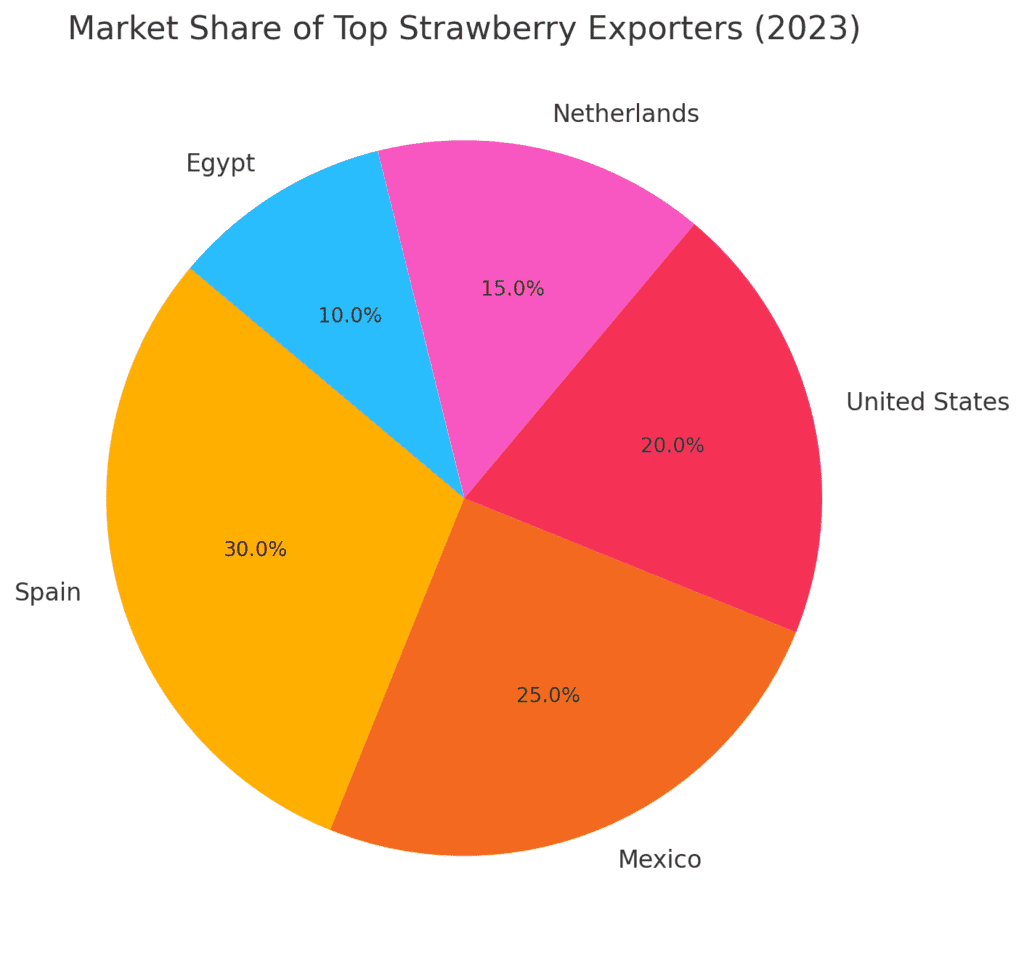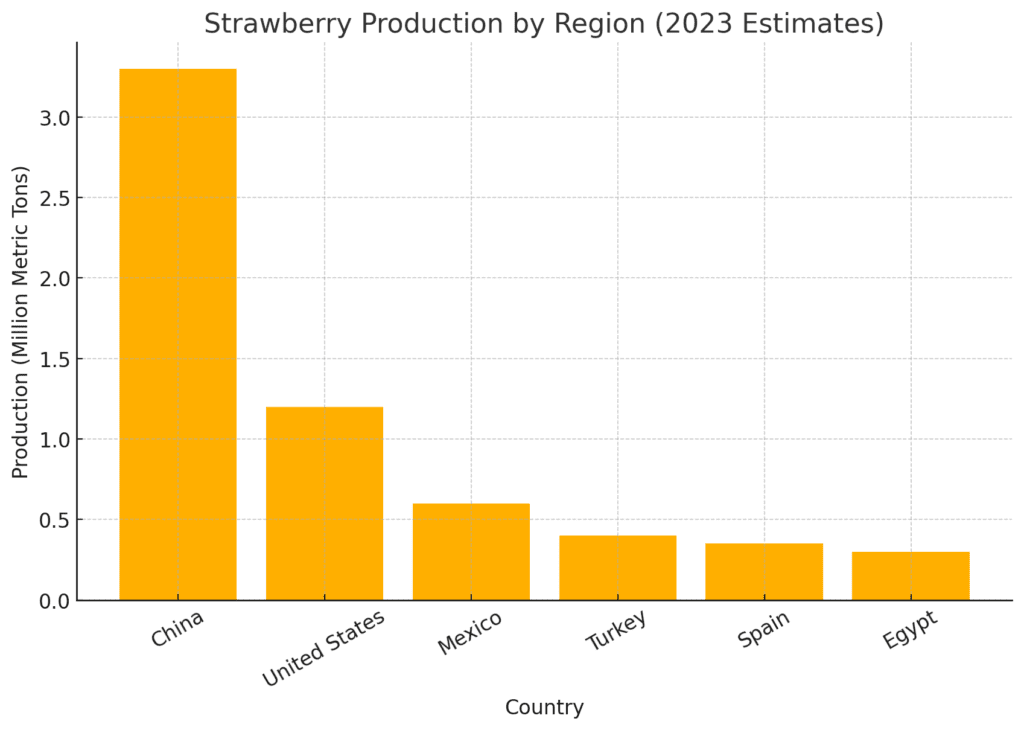Introduction
The strawberry industry is a significant segment of the global fruit market, with widespread cultivation across temperate and subtropical regions. Strawberries are highly popular due to their versatility, nutritional benefits, and year-round availability through global trade. This report provides a detailed analysis of the worldwide strawberry industry, covering production trends, leading markets, trade statistics, challenges, and future outlook.
Global Strawberry Production
Top Strawberry-Producing Countries
Strawberries are cultivated in over 70 countries worldwide, with the leading producers being:
- China – The world’s largest strawberry producer, accounting for nearly 40% of global output.
- United States – Primarily grown in California and Florida, the U.S. is a major exporter.
- Mexico – A key supplier to North America and Europe, known for its year-round production.
- Turkey – Significant producer in the Middle East and Europe.
- Spain – A leading exporter to European markets, especially during winter months.
- Egypt – Emerging as a major player, benefiting from favorable growing conditions.
- South Korea & Japan – Known for high-quality, premium strawberries.
Strawberry Production by Region (2023 Estimates)
| Country | Production Volume (Million Metric Tons) |
|---|---|
| China | 3.3 |
| United States | 1.2 |
| Mexico | 0.6 |
| Turkey | 0.4 |
| Spain | 0.35 |
| Egypt | 0.3 |
Key Factors Influencing Production
- Climate conditions: Strawberries require well-drained soil and moderate temperatures.
- Advancements in cultivation: Greenhouses and hydroponics extend production seasons.
- Labor availability: Harvesting is labor-intensive, impacting production costs.
- Pesticide regulations: Compliance with international safety standards affects exports.

Global Strawberry Trade and Market Trends
Export and Import Markets
The global trade of strawberries is driven by fresh and frozen varieties. Leading exporters and importers include:
Top Strawberry Exporters (2023 Data):
- Spain – Largest exporter to the EU.
- Mexico – Primary supplier to the U.S.
- United States – Exporting mainly to Canada and Asia.
- Netherlands – Major re-exporter within Europe.
- Egypt – Growing influence in the Middle East and Asia.
Top Strawberry Importers (2023 Data):
- United States – The largest importer, mainly from Mexico and Canada.
- Germany – A major consumer in Europe.
- France – Imports from Spain and Morocco.
- United Kingdom – Reliant on Spanish and Dutch supplies.
- Japan – Prefers high-quality imports from the U.S. and South Korea.
Price Trends and Market Value
- The global strawberry market was valued at approximately $18 billion in 2023, with expected growth at a CAGR of 5.2% through 2030.
- Prices fluctuate seasonally, with peaks during off-season months due to limited supply.
- Organic strawberries command premium prices, with increasing consumer demand.
Challenges Facing the Strawberry Industry
1. Climate Change and Weather Variability
- Extreme temperatures and unpredictable weather impact yields.
- Droughts and flooding threaten production in key regions.
2. Labor Shortages and Rising Costs
- The industry relies heavily on manual labor.
- Immigration policies and wage increases affect harvesting costs.
3. Pest and Disease Management
- Strawberry crops are vulnerable to pests like spider mites and diseases such as Botrytis (gray mold).
- Stricter pesticide regulations increase production challenges.
4. Supply Chain Disruptions
- Transportation delays impact freshness and shelf life.
- Rising logistics costs due to fuel prices and regulatory changes.
5. Competition from Alternative Berries
- Blueberries, raspberries, and blackberries compete for market share.
- Consumer preference shifts toward exotic fruit varieties.
Technological Innovations in Strawberry Farming
1. Precision Agriculture and Automation
- Use of drones and AI for monitoring crops and optimizing irrigation.
- Robotic harvesting developments to reduce labor dependency.
2. Vertical and Hydroponic Farming
- Urban farming solutions extend growing seasons and maximize yields.
- Hydroponic systems minimize water usage and pesticide reliance.
3. Genetic Improvements and Biotechnology
- Development of disease-resistant and longer shelf-life strawberry varieties.
- CRISPR technology being explored for flavor and texture enhancements.
4. Sustainable Packaging and Post-Harvest Technologies
- Innovations in biodegradable and recyclable packaging.
- Controlled atmosphere storage extends strawberry freshness.
Consumer Trends and Market Opportunities
1. Growing Demand for Organic Strawberries
- The organic strawberry market is expanding, especially in North America and Europe.
- Consumers prioritize pesticide-free and non-GMO products.
2. Rise of Plant-Based and Functional Foods
- Strawberries are increasingly used in plant-based beverages, snacks, and desserts.
- High vitamin C content boosts demand for strawberry-infused health foods.
3. E-commerce and Direct-to-Consumer Sales
- Online fresh produce delivery is growing rapidly.
- Subscription models for organic and farm-fresh strawberries.
4. Expansion into Emerging Markets
- Rising disposable income in Asia and the Middle East fuels strawberry consumption.
- Increased urbanization supports demand for convenient fresh fruit options.
Future Outlook: The Road Ahead
The global strawberry industry is poised for steady growth, driven by:
- Expansion of greenhouse and hydroponic farming for year-round production.
- Advancements in automation and AI to enhance efficiency.
- Sustainability initiatives in packaging and supply chain management.
- Strategic market expansion in Asia and the Middle East.
However, challenges such as climate change, labor shortages, and trade regulations require proactive strategies to maintain industry stability.
Conclusion
The global strawberry industry remains a dynamic and evolving sector. With technological innovations, expanding markets, and rising consumer demand for healthier food choices, the industry is set to experience continued growth. Stakeholders must focus on sustainability, efficiency, and quality improvements to stay competitive in the ever-changing landscape.

References:



